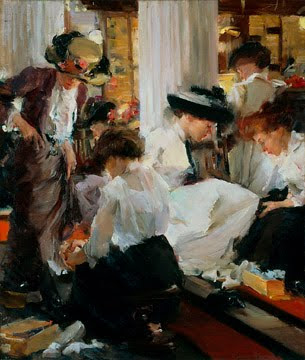New Book on a Rediscovered Painter

It's by a painter known today by very few, but at the beginning of the 20th century the artist was widely considered one of the country's most promising rising stars. The above oil painting is Shoe Shop by Elizabeth Sparhawk-Jones (from the Permanent Collection of the Pennsylvania Academy of the Fine Arts, Philadelphia). An art critic writing in the New York Times reviewing a 1907 Pennsylvania Academy of the Fine Arts (PAFA) exhibition exclaimed Jones was "knocking at the door" and added that a work by her teacher, the legendary William Merritt Chase looked "tame and stilted by comparison with the jubilant performance of Miss Jones." (How that line must have burned good old Chase).
I found that juicy review in the new book by an old friend of mine, Barbara Lehman Smith, who I met, of all places, in a step aerobics class at my gym some years ago. We're both still kicking, which goes to prove exercise is good for you. Below is another Sparhawk-Jones oil I love.
Elizabeth Sparhawk-Jones, Rittenhouse Square, oil,
private collection
Barbara was then starting to write a book on a little known painter, Elizabeth Sparhawk-Jones. This all began when Sparhawk-Jones' papers were accidentally sent to the office where Smith was working as a public relations writer. Saved by chance from the incinerator, the papers and scrapbooks of the painter intrigued my friend to begin what became a years long research project. Elizabeth Sparhawk-Jones had gone from being a hot young star artist (while still in school at PAFA she sold paintings for the equivalent in today's currency of $50,000) to complete anonymity. That's not the kind of story any artist likes to hear about any fellow artist's ultimate fate.
Sparhawk-Jones studied with some of the best, including William Merritt Chase, the central American Impressionist painter at PAFA, one of the two oldest art schools in the US. The other one is the school I've taught at in Baltimore since 1973, the Maryland Institute College of Art. I learned Sparkhawk-Jones had grown up in Baltimore and that her father had been the minister at the historic Brown Memorial Presbyterian Church in the Bolton Hill section of Baltimore. The church lies only a couple of blocks from the classrooms where I've been teaching drawing in MICA's 1904 Main Building.
How could Sparhawk-Jones who grew up in a neighborhood I knew so well have gone from being a young superstar (she was collected by luminaries such as Hollywood's Claude Rains, a star from the film Casablanca) to an almost unknown artist?
Sparhawk-Jones' father suffered from severe chronic depression back in a time when that disease was considered totally scandalous. Like everyone then, he struggled to conceal his illness. Finally unable to function, he was forced to leave his post at the church near my school. Some years later his emotional equilibrium began to return and he secured a position ministering to a socially prominent congregation in Philadelphia.
private collection
Here's the book's cover.
by Alice Kent Stoddard, 27 x 20", PAFA
Elizabeth Sparhawk-Jones, Soldiers Bathing,
Addison Gallery of Art, Andover, MAA
Here's an example of the work of Sparhawk-Jones' key teacher, William Merritt Chase.
In her twenties and already something of a star, Sparhawk-Jones' emotional life collapsed as she fell victim to the same clinical depression that had interrupted her father's life. Formerly a vivacious and extroverted painter, she withdrew from the world and suffered her pain privately. She stopped painting. This was at a time when there were no effective antidepressant medications. In short, she must have gone through hell.
Years passed and her depression gradually receded. She resumed painting, but her later work was of a fundamentally different character. Despite her prolonged absence from the art scene, she was able to gain a new following for the more modern and introspective work. She had exhibitions in New York at the prestigious Rehn Gallery and at Graham Galleries.
Elizabeth Sparhawk-Jones, Leda and the Swan,
watercolor, 27 1/2 x 20", private collection
Elizabeth Sparhawk-Jones, Injustice,
watercolor on linen, approx. 40 x 20", PAFA
Also later in her life she came to know art and artists well outside of the traditional realism of Chase and the PAFA of the early 20th century. One artist whose work she enthusiastically supported was that of the African American painter Horace Pippin. Below is his oil Card Players.
And she became especially close to the American modernist Marsden Hartley. One of his oils is pictured below.
Sparhawk-Jones' career speaks of incisive talent and vision, perilous fragility, and the possibility of healing. It also shows an amazing artistic evolution. My personal favorites are the earlier work in her career, but I have to see her late darker imagery as an authentic response to the emotional difficulty she faced. She has quite a story. Smith's book is especially good at evoking the times in which she lived and chronicling the personalities of the remarkable number of artists and writers she held as close friends.
Barbara Lehman Smith will be appearing Sat. Nov. 13 at Greetings and Readings of Hunt Valley (just north of Baltimore) as part of their Book Fest! from 1-4 p.m.
The Pennsylvania Academy of the Fine Arts in Philadelphia will host a talk by Smith on her
book on February 23 at noon as part of their Art-at-Lunch series.












